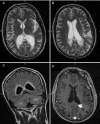The difficulty in diagnosing X linked adrenoleucodystrophy and the importance of identifying cerebral involvement
- PMID: 25969497
- PMCID: PMC4434265
- DOI: 10.1136/bcr-2015-209732
The difficulty in diagnosing X linked adrenoleucodystrophy and the importance of identifying cerebral involvement
Abstract
Two patients are described, a mother and son, who were initially clinically diagnosed with hereditary spastic paraparesis. This was rectified after very long chain fatty acid testing confirmed adrenomyeloneuropathy (AMN). The son's initial symptoms were characteristic of AMN (the commonest phenotype) but progressed to show symptoms of cerebral involvement. This evolution from non-cerebral to cerebral AMN is recognised in the medical literature and is increasingly important to consider in light of the availability of potential treatments such as haematopoietic stem cell transplantation.
2015 BMJ Publishing Group Ltd.
Figures




Similar articles
-
[Adrenomyeloneuropathy: a form of X-linked adrenoleukodystrophy. Report of a family].Neurol Neurochir Pol. 1999 Sep-Oct;33(5):1173-85. Neurol Neurochir Pol. 1999. PMID: 10672567 Polish.
-
Adrenomyeloneuropathy, a dynamic progressive disorder: brain magnetic resonance imaging of two cases.Neuroradiology. 2004 Apr;46(4):296-300. doi: 10.1007/s00234-003-1096-8. Epub 2004 Mar 4. Neuroradiology. 2004. PMID: 15007575
-
Leukodystrophies underlying cryptic spastic paraparesis: frequency and phenotype in 76 patients.Eur J Neurol. 2014 Jul;21(7):983-8. doi: 10.1111/ene.12423. Epub 2014 Apr 2. Eur J Neurol. 2014. PMID: 24698313
-
X-Linked adrenoleukodystrophy: overview and prognosis as a function of age and brain magnetic resonance imaging abnormality. A study involving 372 patients.Neuropediatrics. 2000 Oct;31(5):227-39. doi: 10.1055/s-2000-9236. Neuropediatrics. 2000. PMID: 11204280 Review.
-
Adrenomyeloneuropathy as a cause of primary adrenal insufficiency and spastic paraparesis.CMAJ. 2004 Oct 26;171(9):1073-7. doi: 10.1503/cmaj.1032006. CMAJ. 2004. PMID: 15505272 Free PMC article. Review.
Cited by
-
X-linked cerebral adrenoleukodystrophy.BMJ Case Rep. 2023 Oct 31;16(10):e237905. doi: 10.1136/bcr-2020-237905. BMJ Case Rep. 2023. PMID: 37907311
-
Management of X-linked adrenoleukodystrophy in Morocco: actual situation.BMC Res Notes. 2017 Nov 7;10(1):567. doi: 10.1186/s13104-017-2902-4. BMC Res Notes. 2017. PMID: 29116030 Free PMC article.
References
Publication types
MeSH terms
LinkOut - more resources
Full Text Sources
Other Literature Sources
